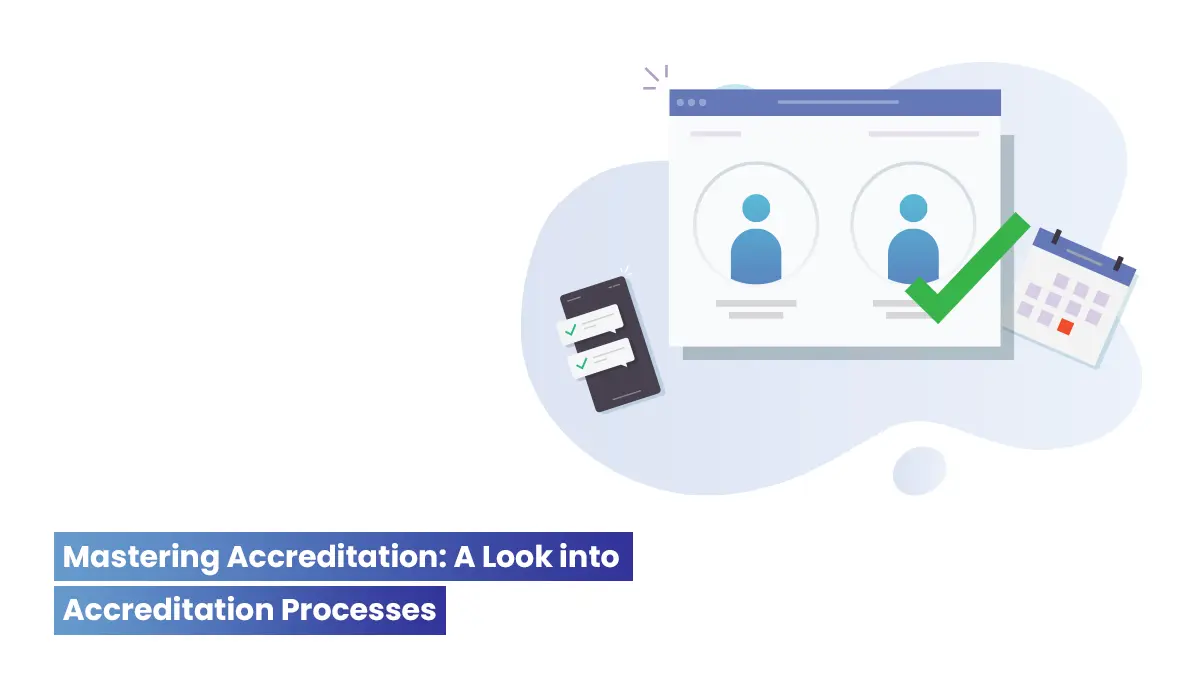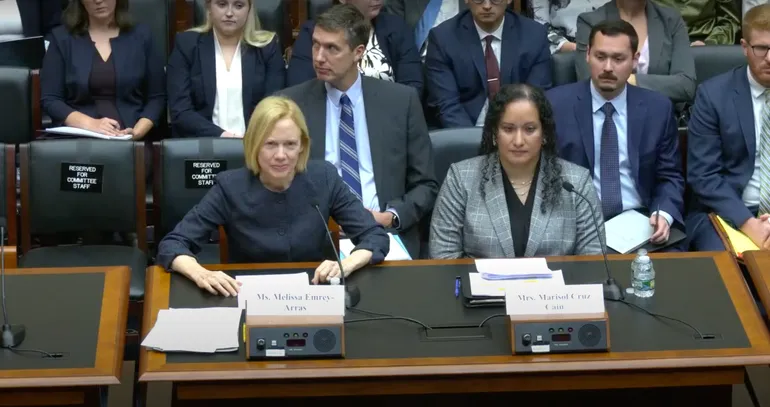Introduction
Currently, there are over 200 million students enrolled in higher education worldwide; by 2030, that number is predicted to soar by an additional 40 percent. How do we guarantee that these institutions maintain the highest caliber during such a surge? At this moment, accreditation enters the picture and serves as an essential stage in the educational system. Encouraging a culture of accountability and continual development is more important than just checking boxes. This blog provides leaders in higher education and accreditation committees worldwide with a useful resource as we walk you through the Global Accreditation Process and criteria. Together, let’s explore how we might improve institutional quality through benchmarking.
Understanding Accreditation
Now, describe accreditation in more detail. To put it plainly, accreditation is the process of an outside organization assessing a program or institution to make sure it satisfies requirements for quality assurance. Consider it an endorsement, signifying the excellent caliber of the education offered.
Institutional and programmatic accreditation are the two primary categories. Examining the entire institution, from student services to governance, is what institutional accreditation looks at. Conversely, programmatic accreditation makes sure that certain programs—like engineering or nursing—meet industry requirements inside the university.
Now, what makes accreditation and accreditation processes so important? It does this, among other things, by confirming the caliber of education, and increasing the value and international recognition of degrees. Additionally, it promotes an excellence-focused atmosphere by pushing institutions to keep becoming better. A well-regarded education that will be valued by businesses and other educational institutions is what accreditation assures students of. It guarantees that the entire team operates in a setting that is respected and encouraging. Besides, accreditation in education provides stakeholders—parents and employers, among others—with the assurance that the education they get is rigorous and reliable.
Types of Accreditation
Let’s examine the many accreditation categories.

First, accreditation: national versus regional. Generally speaking, some kinds of institutions—such as vocational schools or religious colleges—are subject to national accreditation. Compared to regional accreditation, which is the gold standard for the majority of conventional business schools and universities, it is frequently less stringent. Regional accreditation has accreditation processes that assesses educational institutions in a particular region to make sure they adhere to strict quality criteria. Examples of accrediting organizations are the Accrediting Council for Independent Colleges and Schools (ACICS) for national accreditation and the Higher Learning Commission (HLC) in the United States for regional certification.
The next type of accreditation is programmatic or specialized. This focuses on particular initiatives inside an organization and makes sure they adhere to standards set by the industry. Specialized certification is frequently sought after by the business (AACSB), engineering (ABET), and nursing (CCNE) fields. For programs to stay in business and guarantee that their graduates are ready for the workforce, they must have this kind of certification.
The Accreditation Process
Let’s get started with the accreditation processes or procedure now.
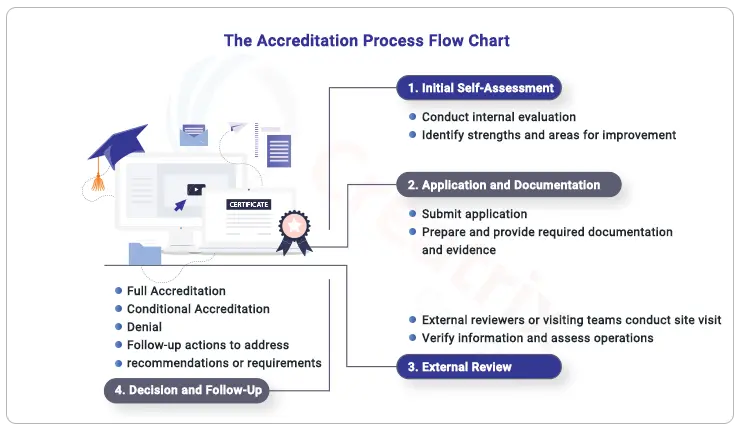
First Self-Evaluation
Institutions start by assessing their own performance in comparison to accrediting requirements by self-assessment. Because it assists in identifying areas for progress as well as strengths, this internal appraisal is essential.
Utilization and Record-Keeping
The organization then files an application and copious amounts of supporting documents. This includes evidence that demonstrates compliance with accreditation standards, such as policies, procedures, and performance data.
Review from Outside
Next, outside evaluators or visiting groups take over. They visit the location to confirm the details given and get a personal look at how the institution is run. Making ensuring the institution really satisfies the necessary requirements is their main goal.
Choice and Confirmation
Lastly, the review is used by the accrediting authority to inform its conclusion. Denials, provisional accreditation, and full accreditation are possible results. Institutions might have to follow up with recommendations or mandates for improvement.
Standard Accreditation Criteria
Global accrediting organizations usually concentrate on a few essential criteria:
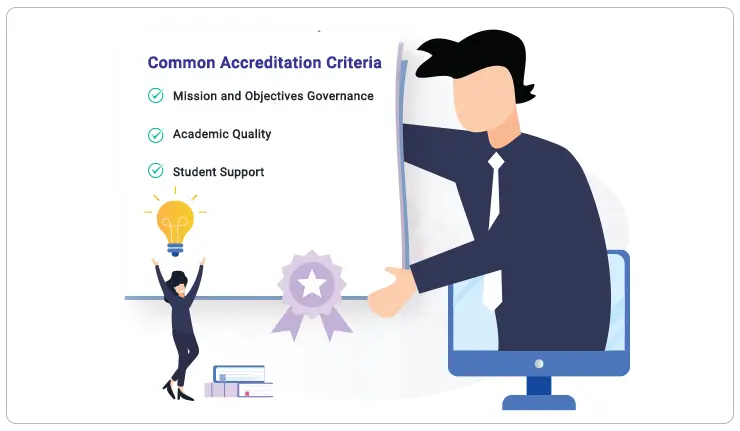
Mission and Objectives: The institution’s objectives should be in line with the courses it offers.
Governance: The stability and integrity of an institution depend on strong leadership and sound governance practices.
Quality in Academics: Ensuring excellent research, teaching, and learning activities is known as academic quality.
Student Support and Experience: Enough resources and services must be made available to students in order to support their achievement.
Constant Enhancement in Higher Education Accreditation
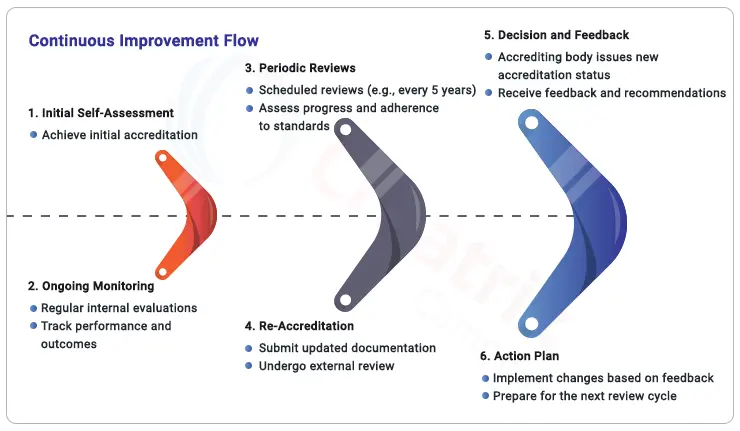
Obtaining accreditation is a continuous process rather than a “one-and-done” affair. Institutions are always looking for ways to improve their accreditation performance, procedures and results. A recent poll found that 78% of certified schools believe that upholding good standards requires regular assessments and re-accreditation.
This continuous procedure in Accreditation in Education fosters an excellence-oriented culture in addition to guaranteeing they maintain compliance with certification regulations. Institutions may successfully adjust to changing educational needs and establish new success standards by embracing continual improvement.
Challenges in Global Accreditation
A multitude of obstacles that institutions must overcome might make the certification process intimidating. Navigating the realm of accreditation is not always easy. Some of the most typical obstacles are listed below:
Challenging Documentation
The amount of paperwork required might be daunting. Because they have less advanced systems, schools in impoverished countries may find it difficult to acquire data, which makes paperwork a major burden.
Restricted Resources
Many institutions, particularly those in locations with limited resources, struggle to set aside the money and administrative assistance required for the rigorous accrediting procedure.
Regional and Cultural Differences
Every area has distinct norms and expectations that may seem to conflict with the requirements of worldwide certification. Because what is seen as best practice in one place can not easily fit with local customs or norms, navigating these variances can be challenging.
Data Security and Privacy
When managing data across many jurisdictions with disparate rules, it might be very important to make sure that private and sensitive student and institutional data satisfies international standards for security and privacy.
Conforming to Changing Requirements
Staying Ahead of Changing Requirements The requirements for accreditation are always changing. Keeping up with the newest technological advances and creative teaching techniques might be difficult for institutions to implement. To remain up to date, one must always be alert and adaptable.
Integration Problems
Institutions adopting accreditation in education frequently have trouble combining new and outdated technologies. For instance, it might be difficult to match data management systems to accrediting organizations’ reporting specifications.
Technological Adaptability
It might be difficult to stay on top of the most recent developments in technology. 62% of institutions report having trouble integrating new technology with their current systems, according to a recent Educause research.
Digital Infrastructure
It might be very difficult to apply the technologies required for certification in areas where digital infrastructure is still growing. In low-resource locations,3 a major amount of institutions encounter major challenges when attempting to implement advanced learning management systems (LMS) and data analytics technologies. This disparity may impede their capacity to efficiently fulfill international accrediting standards.
Conclusion
Finally, certification is evidently more than just a box to be checked; rather, it is a continuous dedication to quality. A maze of paperwork, changing standards, and overcoming local obstacles must all be navigated during the accreditation processes. It’s all a part of the effort to uphold and improve the standard of education globally, though.
While accreditation is a dynamic process that keeps schools ahead of the curve in an ever-evolving educational world, it is not a static achievement. The secret to steering this tricky path? Using automation in the procedures you use for certification. Eliminate manual labor, simplify your work, and easily maintain compliance with international standards.
We can help you with everything from the MQA, and AACSB, to the Accreditation Council for Business Schools and Programs. Our products are made to work with all of the major accrediting bodies in the globe, so you can always be up to date with the most recent regulations.
Are you looking for ways to streamline your accreditation process? Examine our accreditation management automation tools to see how they may transform your accrediting procedure and help you maintain the highest standards for institutional quality. Contact us today.
#Benchmarking #Institutional #Quality #Global #Accreditation #Process






